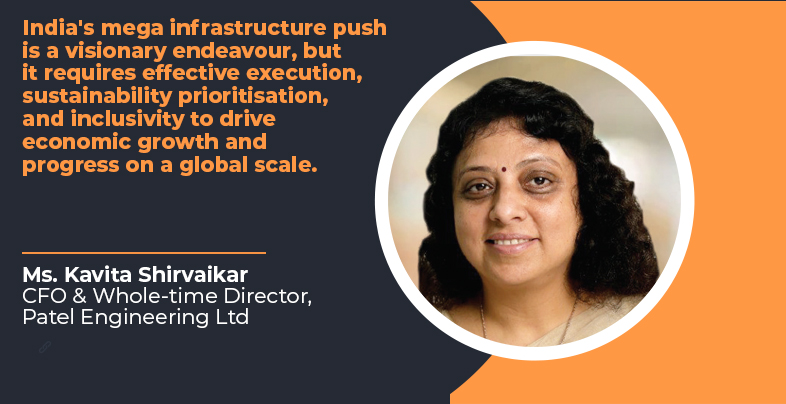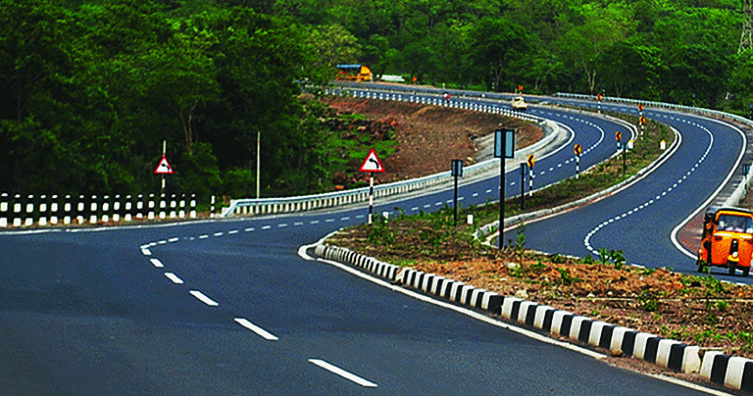Mega infrastructure push is not just about constructing physical assets
By Edit Team | October 27, 2023 3:40 pm SHARE

India’s mega infrastructure push is a visionary endeavour, but it requires effective execution, sustainability prioritisation, and inclusivity to drive economic growth and progress on a global scale.
With its rich history, diverse culture, and growing economy, India is on the cusp of a transformative journey. At the heart of this transformation lies a monumental endeavour – a mega infrastructure push that seeks to revolutionise infrastructure development, fuel economic growth, and promote sustainable progress. The government of India embarked on a mission to build world-class infrastructure that not only addresses current needs but also lays the foundation for future growth.
The need for an infrastructure push has been facilitated by the surge in India’s urban population, which is expected to reach 600 million by 2031. In Budget 2022-23, India focused on pushing the economy by investing in various infrastructure projects. For infrastructure, Rs 10 lakh crore (3.3 percent of GDP) was allocated in the budget 2023-24, an increase of three times from 2019. The government has also been focusing on developing smart cities and efficient urban planning through the Smart City Plan introduced in 2015. These cities are designed to have affordable housing, digitisation and IT connectivity, a sustainable environment, and safety and security for the vulnerable members of society.

To facilitate this surge in population and enhance industrial growth, the government established five industrial corridors through the National Industrial Corridor Development and Implementation Trust (NICDIT). These zones encourage industries’ setting up, creating jobs, and stimulating economic development in specific regions. The Delhi-Mumbai Industrial Corridor (DMIC) is a prime example of an initiative covering Uttar Pradesh, Haryana, Rajasthan, Madhya Pradesh, Gujrat, and Maharashtra.
Another critical element of the infrastructure push is improving connectivity. India’s vast and diverse landscape demands a well-connected network of roads, highways, railways, and waterways. Roads and railroads alone accounted for half of the Centre’s overall capital expenditure during the past two years. The investments by the Indian government in the roads and highways sector increased by a CAGR of over 40 percent, and the railway sector witnessed the government capex rise at a CAGR of 37 percent in recent years.
An important strategy for the success of India’s infrastructure push is the partnerships between the public and private sectors or the PPP approach (Public-Private Partnership). PPPs are considered efficient options for infrastructure growth as they combine the advantages of harnessing private sector technological, managerial efficiency, and allocative efficiency advantage of the government sector. Recently, the Public Private Appraisal Committee appraised 345 projects of a total project cost of 5,15,000 crores.
The Indian government has also set ambitious targets for renewable energy adoption to promote sustainable growth. India has set a target to reduce the carbon intensity of the nation’s economy by less than 45% by the end of the decade, achieve 50 percent cumulative electric power installed by 2030 from renewables, and achieve net-zero carbon emissions by 2070. India aims for 500 GW of renewable energy installed capacity by 2030. With the government’s focus to improve the capacity of renewable energy, hydropower remains systemically important from the grid perspective to meet the flexibility requirements and peak power supply.
As these infrastructure projects increase, there is a growing demand for skilled labour. Investing in skill development programs is imperative to ensure that the workforce is equipped to contribute effectively to the construction and maintenance of infrastructure. The Make in India initiative by the Indian government aims to boost the manufacturing sector by improving the business environment, encouraging investment, and promoting innovation.
Proper assessments and mitigation measures should be in place to minimise ecological impacts. As land acquisition for large-scale projects can be contentious, ensuring fair compensation to affected communities and addressing land rights issues is crucial. Another issue to be aware of is infrastructure projects worldwide suffering from cost overruns. Transparent budgeting and project management are vital to prevent this. Building infrastructure is one thing; maintaining it sustainable is another. Adequate funding and a robust maintenance strategy are essential.
India’s mega infrastructure push is not just about constructing physical assets; it’s about laying the foundation for a brighter future. By investing in connectivity, renewable energy, smart cities, industrial corridors, and fostering public-private partnerships, India is poised to transform its economy and society. However, addressing challenges, prioritising sustainability, and ensuring inclusivity in the development process is essential. If executed effectively, this visionary endeavour will propel India towards greater economic growth, improved living standards, and sustainable progress on a global scale.
Authored by – Ms. Kavita Shirvaikar, CFO & Whole-time Director, Patel Engineering Ltd
Cookie Consent
We use cookies to personalize your experience. By continuing to visit this website you agree to our Terms & Conditions, Privacy Policy and Cookie Policy.




































-20240213125207.png)

























